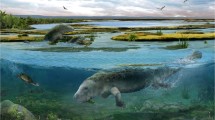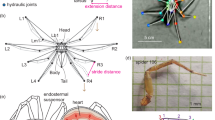Abstract
Caecilians are an ancient and enigmatic group of limbless, burrowing amphibians found throughout most of the humid tropics1,2. Over the past 100 million years, the majority of caecilian lineages seem to have retained a series of highly derived musculoskeletal traits from a common ancestor. Among these features are unusually oriented body wall muscles3 and a vertebral column that moves independently of the skin4–9. Until now, these strange characteristics have defied a satisfying functional explanation. Our data suggest that the unique morphology of caecilians enables them to power locomotion hydrostatically by applying force to a crossed-helical array of tendons that surrounds their body cavity. Using this system, the Central American Dermophis mexicanus can generate approximately twice the maximum forward force as similar-sized burrowing snakes that rely solely on longitudinally oriented musculature of the body wall and vertebral column for forward force production. Although many groups of invertebrates use hydrostatic systems to move10–13 and many vertebrates use hydrostatic systems in localized body parts13,14, caecilians are the first vetebrates known to use the entire body as a hydrostatic system for locomotion.
Similar content being viewed by others
References
Nussbaum, R. A. & Wilkinson, M. Herpet. Monogr. 3, 1–42 (1989).
Hedges, S. B., Nussbaum, R. A. & Maxson, L. R. Herpet. Monogr. 7, 64–76 (1993).
Nussbaum, R. A. & Naylor, B. G. J. Zool. 198, 383–398 (1982).
Schnurbein, A. F. von Morphol. Jahrb. 75, 315–330 (1935).
Gaymer, R. Nature 234, 150–151 (1971).
Gans, C. Nature 242, 414–415 (1973).
Ducey, P. K., Formanowicz, D. R., Boyet, L., Mailloux, J. & Nussbaum, R. A. Herpetologica 49, 450–457 (1993).
Wake, M. H. in The Skull Volume 3 (eds Hanken, J. & Hall, B. K.) 197–240 (University of Chicago Press, Chicago, 1993).
Summers, A. P. & O'Reilly, J. C. Zool. J. Linn. Soc. (in the press).
Wainwright, S. A., Biggs, W. D., Currey, J. D. & Gosline, J. M. Mechanical Design of Organisms (Wiley, New York, 1976).
Wainwright, S. A. Naturwissenschaften 57, 321–326 (1970).
Chapman, G. J. Exp. Zool. 194, 249–270 (1975).
Kier, W. M. & Smith, K. K. Zool. J. Linn. Soc. 83, 307–324 (1985).
Ritter, D. A. & Nishikawa, K. C. J. Exp. Biol. 198, 2025–2040 (1995).
Gans, C. Biomechanics. An Approach to Vertebrate Biology (University of Michigan Press, Ann Arbor, 1974).
Carrier, D. R. & Wake, M. H. J. Morphol. 226, 289–295 (1995).
Gray, J. J. Exp. Biol. 23, 101–120 (1946).
Jayne, B. C. J. Exp. Biol. 140, 1–33 (1988).
Hochachka, P. W. Muscles as Molecular Machines (CRC Press, Boca Raton, 1994).
Deban, S. M., O'Reilly, J. C. & Theimer, T. J. Exp. Zool. 270, 451–459 (1994).
Comroe, J. Physiology of Respiration (Yearbook Medical, Chicago, 1974).
Author information
Authors and Affiliations
Rights and permissions
About this article
Cite this article
O'Reilly, J., Ritter, D. & Carrier, D. Hydrostatic locomotion in a limbless tetrapod. Nature 386, 269–272 (1997). https://doi.org/10.1038/386269a0
Received:
Accepted:
Issue Date:
DOI: https://doi.org/10.1038/386269a0
- Springer Nature Limited
This article is cited by
-
Triassic stem caecilian supports dissorophoid origin of living amphibians
Nature (2023)
-
Giant negative linear compressibility in zinc dicyanoaurate
Nature Materials (2013)
-
The origin and early evolution of chordates: The ‘Hydroskelett-Theorie’ and new insights towards a metameric ancestor
Senckenbergiana lethaea (2002)





